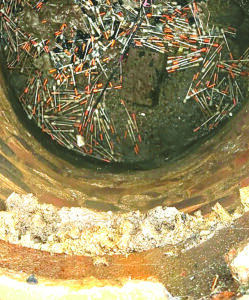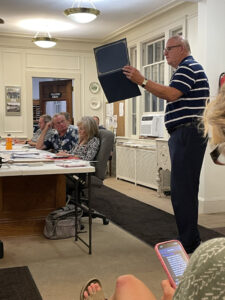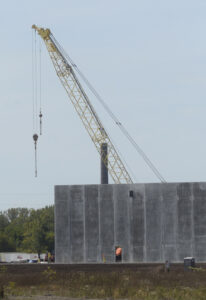Hundreds of needles expose need to demolish YS&T homes in Campbell

Submitted photo / George Levendis... This catch basin on Chambers Street near the historic Youngstown Sheet & Tube Co. homes in Campbell is the site of hundreds of discarded hypodermic needles and other drug paraphernalia.
CAMPBELL — George Levendis has a photograph of a single catch basin about 2 feet deep filled with hundreds of discarded hypodermic needles — a situation that has further fueled his desire to clean up a blighted section of the city.
“I do not intend to let anyone hold up the demolitions,” Levendis, city council president, said after Wednesday’s council meeting.
The basin is on Chambers Street, one of the roads that leads to the historic Youngstown Sheet & Tube Co. homes, most of which he, council members and others describe as dangerous to those who live in them and to neighbors because of their deplorable condition — making it imperative that they are torn down.
Underscoring the urgency to get rid of the precast concrete homes is the fatal Dec. 31 fire at 20 Andrews St. that killed 38-year-old Ami Maldonado, Levendis stressed. Her unit had no working utilities, which violated a city ordinance, Capt. Greg Rosile of the Campbell Fire Department said.
So far, about 13 of the estimated 70 seven-unit company buildings have been razed, at a cost between $7,000 and $10,000 per unit, Levendis noted.
Many of the buildings line Robinson Road as well as Andrews, Blackburn and Chambers streets.
Besides rampant drug use, the numerous problems associated with the buildings include being havens for rodents, squatters building fires to stay warm, exposed wiring, dilapidated roofs and walls, a lack of plumbing, sanitary facilities and utilities, and piles of junk. Some have been looted and had the copper piping stolen, Levendis said.
Also, some residents who live in a home with electricity run a single extension cord to other units, which creates a fire hazard, he explained.
“It’s just an accident waiting to happen,” Levendis said, adding, “Their life expectancy is over.”
In addition, they have been the source of a high level of police activity, as well as so-called “blind purchases,” in which out-of-town buyers purchase the units for little money after having seen them online, for example, but without seeing them firsthand. After discovering their poor condition, such buyers often walk away instead of making necessary repairs, city Law Director Brian Macala explained.
“The tax delinquency down there is through the roof,” he said.
In late 1915 and early 1916, YS&T workers went on strike mainly because of a 9 percent wage cut. The situation became violent when the city’s business district along Wilson Avenue was burned to the ground, which eventually led to the construction of the concrete homes, Macala noted.
Many immigrants who came to work in the steel mills in Campbell, then known as East Youngstown, lived in the units. The neighborhoods in which the homes had been built during and shortly after World War I remained viable, even several years after the YS&T’s Campbell Works closed Sept. 19, 1977, a day known infamously as “Black Monday,” Macala continued.
In 1982, the homes were placed on the National Register of Historic Places.
Nevertheless, they began to deteriorate over time as the area’s population decreased. Given the units’ present condition, their historic value should not supersede the need to have them come down, Macala and Levendis said.
“We’re going to keep moving forward and knocking the buildings down and send the message that the city is not going to take the condition of the area in general,” Levendis added.
The law director also praised Deb Flora, the Mahoning County Land Bank’s executive director, for her agency’s work with the city on the project.
news@vindy.com



